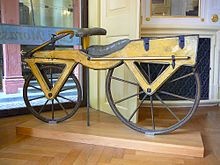Vehicles for human transport that have two wheels and require balancing by the rider date back to the early 19th century. The first means of transport making use of two wheels arranged consecutively, and thus the archetype of the bicycle, was the German draisine dating back to 1817. The term bicycle was coined in France in the 1860.
Earliest unverified history
There are several early, but unverified, claims for the invention of bicycle-like machines.
The earliest comes from a sketch said to be from 1493 and attributed to Gian Giacomo Caprotti, a pupil of Leonardo da Vinci. In 1998 Hans-Erhard Lessing described this as a purposeful fraud. However, the authenticity of the bicycle sketch is still vigorously maintained by followers of Prof. Augusto Marinoni, a lexicographer and philologist, who was entrusted by the Commissione Vinciana of Rome with the transcription of da Vinci's Codex Atlanticus.
Later, and equally unverified, is the contention that Comte de Sivrac developed a célérifère in 1791, demonstrating it at thePalais-Royal in France. The célérifère supposedly had two wheels set on a rigid wooden frame and no steering, directional control being limited to that attainable by leaning. A rider was said to have sat astride the machine and pushed it along using alternate feet. It is now thought that the two-wheeled célérifère never existed (though there were four-wheelers) and it was instead a misinterpretation by the well-known French journalist Louis Baudry de Saunier in 1891.
1817 to 1819: the draisine or velocipede
The first verifiable claim for a practically used bicycle belongs to German Baron Karl von Drais, a civil servant to the Grand Duke of Baden in Germany. Drais invented hisLaufmaschine (German for "running machine") of 1817 that was called Draisine(English) or draisienne (French) by the press. Karl von Drais patented this design in 1818, which was the first commercially successful two-wheeled, steerable, human-propelled machine, commonly called a velocipede, and nicknamed hobby-horse ordandy horse. It was initially manufactured in Germany and France. Hans-Erhard Lessing found from circumstantial evidence that Drais' interest in finding an alternative to the horse was the starvation and death of horses caused by crop failure in 1816 ("Eighteen Hundred and Froze to Death," following the volcanic eruption of Tambora in 1815). On his first reported ride from Mannheim on June 12, 1817, he covered 13 km (eight miles) in less than an hour. Constructed almost entirely of wood, the draisine weighed 22 kg (48 pounds), had brass bushings within the wheel bearings, iron shod wheels, a rear-wheel brake and 152 mm (6 inches) of trail of the front-wheel for a self-centering caster effect. This design was welcomed by mechanically minded men daring to balance, and several thousand copies were built and used, primarily in Western Europe and in North America. Its popularity rapidly faded when, partly due to increasing numbers of accidents, some city authorities began to prohibit its use. However in 1866 Paris a Chinese visitor named Bin Chun could still observe foot-pushed velocipedes
.
The concept was picked up by a number of British cartwrights; the most notable wasDenis Johnson of London announcing in late 1818 that he would sell an improved model. New names were introduced when Johnson patented his machine “pedestrian curricle” or “velocipede,” but the public preferred nicknames like “hobby-horse,” after the children’s toy or, worse still, “dandyhorse,” after the foppish men who often rode them. Johnson's machine was an improvement on Drais's, being notably more elegant: his wooden frame had a serpentine shape instead of Drais's straight one, allowing the use of larger wheels without raising the rider's seat. During the summer of 1819 the "hobby-horse", thanks in part to Johnson's marketing skills and better patent protection, became the craze and fashion in London society. The dandies, the Corinthians of the Regency, adopted it, and therefore the poet John Keats referred to it as "the nothing" of the day. Riders wore out their boots surprisingly rapidly, and the fashion ended within the year, after riders on sidewalks were fined two pounds.
Nevertheless, Drais' velocipede provided the basis for further developments: in fact, it was a draisine which inspired a French metalworker around 1863 to add rotary cranks and pedals to the front-wheel hub, to create the first pedal-operated "bicycle" as we today understand the word.

The development of the safety bicycle was arguably the most important change in the history of the bicycle. It shifted their use and public perception from being a dangerous toy for sporting young men to being an everyday transport tool for men—and, crucially, women—of all ages.
Aside from the obvious safety problems, the high-wheeler's direct front wheel drive limited its top speed. One attempt to solve both problems with a chain-driven front wheel was the dwarf bicycle, exemplified by the Kangaroo. Inventors also tried a rear wheel chain drive. Although Harry John Lawson invented a rear-chain-drive bicycle in 1879 with his "bicyclette", it still had a huge front wheel and a small rear wheel. Detractors called it "The Crocodile", and it failed in the market.
John Kemp Starley, James's nephew, produced the first successful "safety bicycle" (again a retrospective name), the "Rover," in 1885, which he never patented. It featured a steerable front wheel that had significant caster, equally sized wheels and a chain drive to the rear wheel.



